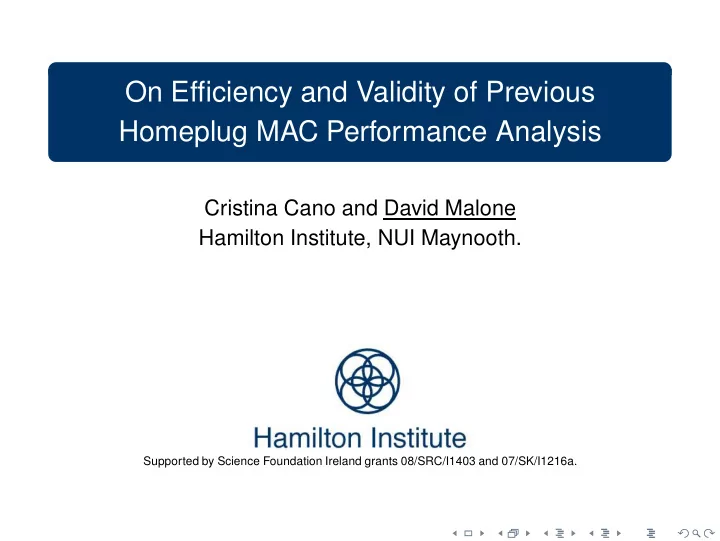

On Efficiency and Validity of Previous Homeplug MAC Performance Analysis Cristina Cano and David Malone Hamilton Institute, NUI Maynooth. Supported by Science Foundation Ireland grants 08/SRC/I1403 and 07/SK/I1216a.
MAC Modeling The Homeplug/1901 MAC similar to 802.11’s DCF. 802.11’s MAC extensively studied using Bianchi’s model 1 and extensions. This has been extended to cover the Homeplug/1901 2 . Deferral counter requires extra states in Markov Chain. 1 Bianchi. Performance analysis of the IEEE 802.11 distributed coordination function. Selected Areas in Communi- cations, IEEE Journal on 18.3 (2000): 535-547. 2 Chung et al., Performance analysis of HomePlug 1.0 MAC with CSMA/CA , IEEE Journal on Selected Areas in Communications, vol. 24, no. 7, pp. 1411-1420, 2006.
Solving the model is computationally expensive 1 iteration loop that contains 2 more loops Computationally expensive operations Aimed to simplify model to make it quicker to solve. Same assumptions as considered by Chung et al. Infinite queue size and retry limit. Exponential distributed interarrival of packets. Ideal channel conditions. Contention among homogeneous access categories.
Simplification We take a renewal reward approach 34 . We compute the waiting times at each backoff stage Define the probability to fail at backoff stage i , p ( i ) = p · p ( i ) bo + p ( i ) defer . . f Then compute average time in backoff to successfully transmit. We can precompute deferral probability and expected backoff times. Can also make exponential approx. to simplify further. stations Original Analysis Simplified Exponential 10000s Simulation 10 584.5 s 3.7 s 1.7 s 165.5 s 50 420.0 s 4.2 s 3.5 s 866.2 s 3 Kumar et al., New insights from a fixed point analysis of single cell IEEE 802.11 WLANs , INFOCOM 2005. 4 Bianchi and Tinnirello, Remarks on IEEE 802.11 DCF performance analysis , IEEE Communication Letters, 2005.
Validation Problems
Saturated Conditions Same results as Chung. et al. 6 9 x 10 Exact Calculation Exp. Approx. 8 Simulations 0.25 7 CA1/0 MAC Acccess Delay [s] 6 0.2 Throughput [bits/s] 5 0.15 4 CA3/2 CA3/2 0.1 3 2 CA1/0 0.05 Exact Calculation 1 Exp. Approx. Simulations 0 0 0 10 20 30 40 50 0 10 20 30 40 50 Number of stations (n) Number of stations (n)
Unsaturated Conditions The results were not fitting but prior to saturation only
Explanation
Obtaining Two Solutions Depending on the starting parameters: 6 9 x 10 8 7 n=10 6 Throughput [bits/s] 5 n=30 4 3 n=50 2 1 Analysis 1 Analysis 2 0 0 10 20 30 40 50 60 70 80 λ [packets/s] Due to coupling of queue dynamics and channel access. Something similar in WiFi 5 . 5 Duffy, Mean field Markov models of wireless local area networks , Markov Processes and Related Fields, vol. 16, no. 2, pp. 295-328, 2010.
Temporal Evaluation Evolution of throughput/Queue size (max, av, min): 6 x 10 1000 6 900 5.5 Instantaneous Throughput [bits/s] 800 maximum → 5 Queue Size [packets] 700 4.5 600 ← average 4 500 400 3.5 ← minimum 300 3 200 2.5 100 2 0 0 5 10 15 20 25 30 15.45 15.5 15.55 15.6 15.65 Time [h] Time [h]
Validation Simulations (with pre-loaded queues) fit saturated solution: 6 9 x 10 8 7 n=10 6 Throughput [bits/s] 5 n=30 4 3 n=50 2 Analysis 1 1 Analysis 2 Simulations 0 0 10 20 30 40 50 60 70 80 λ [packets/s]
Summary For large queues: long transitory phase before saturation. Shows up as extra fixed point in model. Can lead to misinterpretation of analysis and simulations. Model improvements for PLC at http://arxiv.org/abs/1401.6803 . Actually present in Wi-Fi and other protocols too. Thinking about practical implications.
Recommend
More recommend